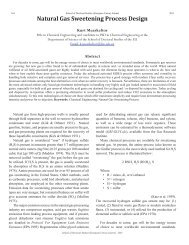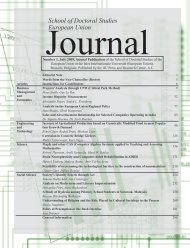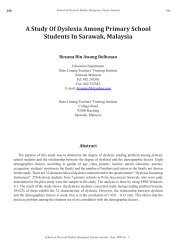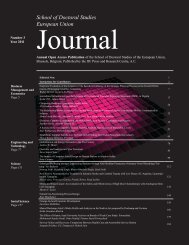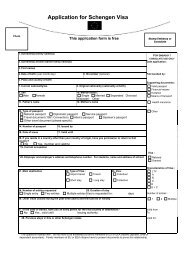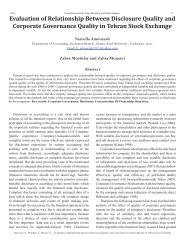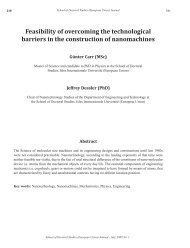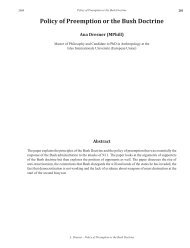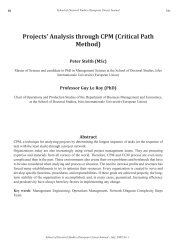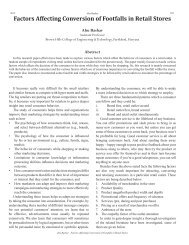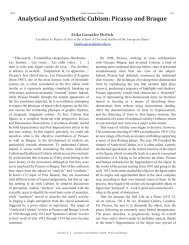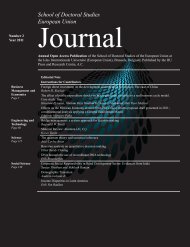An Effective Neuroprotective Treatment in Ischemic Stroke and ...
An Effective Neuroprotective Treatment in Ischemic Stroke and ...
An Effective Neuroprotective Treatment in Ischemic Stroke and ...
Create successful ePaper yourself
Turn your PDF publications into a flip-book with our unique Google optimized e-Paper software.
2011 <strong>An</strong> <strong>Effective</strong> <strong>Neuroprotective</strong> <strong>Treatment</strong> <strong>in</strong> <strong>Ischemic</strong> <strong>Stroke</strong> <strong>and</strong> Cerebral Trauma with Low Doses of L-Arg<strong>in</strong><strong>in</strong>e, Lamotrig<strong>in</strong>e <strong>and</strong> Tianept<strong>in</strong>e 121<br />
<strong>An</strong> <strong>Effective</strong> <strong>Neuroprotective</strong> <strong>Treatment</strong> <strong>in</strong> <strong>Ischemic</strong><br />
<strong>Stroke</strong> <strong>and</strong> Cerebral Trauma with Low Doses of<br />
L-Arg<strong>in</strong><strong>in</strong>e, Lamotrig<strong>in</strong>e <strong>and</strong> Tianept<strong>in</strong>e<br />
Héctor Jara (MD)<br />
Department of Neurochemistry, Neuropharmacology <strong>and</strong> Neuroimmunology, Instituto de Medic<strong>in</strong>a Experimental.<br />
Faculty of medic<strong>in</strong>e, Universidad Central de Venezuela, Caracas, Venezuela; Neuropharmacology Institute at the<br />
“Centro Cl<strong>in</strong>ico Profesional Caracas”, Caracas, Venezuela.<br />
Email: hectorjara2000@hotmail.com<br />
Francisco García (MD)<br />
Neuropharmacology Institute at the “Centro Clínico Profesional Caracas”, Caracas, Venezuela.<br />
Franky Torres (MD)<br />
Department of critical care medic<strong>in</strong>e, Hospital “Dom<strong>in</strong>go Luciani” IVSS, Caracas, Venezuela.<br />
Fuad Lech<strong>in</strong> (MD,PhD)<br />
Department of Neurochemistry, Neuropharmacology <strong>and</strong> Neuroimmunology, Instituto de Medic<strong>in</strong>a Experimental.<br />
Faculty of medic<strong>in</strong>e, Universidad Central de Venezuela, Caracas, Venezuela.<br />
Abstract<br />
In stroke <strong>and</strong> cerebral Trauma the damaged neurons release Aspartate <strong>and</strong> Glutamate that contribute to neuronal death (excitotoxic<br />
cell death). However, physiological levels of NMDA receptor activity can promote neuronal survival <strong>and</strong> resistance to trauma, which<br />
expla<strong>in</strong> why a large number of neuroprotective agents development for stroke have failed to show positive effects <strong>in</strong> Phase III trials<br />
<strong>in</strong> ischemic stroke. The levels of free seroton<strong>in</strong> (f-5HT) <strong>in</strong>crease <strong>in</strong> thrombotic events, worsen<strong>in</strong>g the platelet aggregation <strong>and</strong> the<br />
arteriolar vasoconstriction. Endothelium-derived Nitric Oxide (eNO) is reduced <strong>in</strong> ischemic stroke. The objective of this study was to<br />
evaluate the neuroprotective effects of Lamotrig<strong>in</strong>e (a glutamate release <strong>in</strong>hibitor), Tianept<strong>in</strong>e (reducer of f-5HT levels) <strong>and</strong> L-Arg<strong>in</strong><strong>in</strong>e<br />
(precursor of eNO) at low doses. We performed a controlled study with 49 patients with cerebral trauma <strong>and</strong> 25 patients with ischemic<br />
stroke. We compared the sample groups with control groups that received conventional treatment. To evaluate the disease progression<br />
we used the Glasgow Scale <strong>and</strong> NIHSS. The results were analyzed by F statistical test <strong>and</strong> Student’s t test with p ≤ 0.05. The results<br />
show that patients with stroke <strong>and</strong> bra<strong>in</strong> trauma are benefited with this new neuroprotective treatment (p value < 0.05) with lower rates<br />
of neurologic complications. Key Words: Glutamate, NMDA-receptor signall<strong>in</strong>g, free seroton<strong>in</strong>, endothelial Nitric Oxide, Agmat<strong>in</strong>e,<br />
Pro-survival signal, Neurotoxicity.<br />
Cerebrovascular Diseases (CD), the third lead<strong>in</strong>g cause<br />
of death <strong>in</strong> developed countries after heart diseases <strong>and</strong><br />
cancer, has an overall prevalence of 795 per 100,000 <strong>and</strong> are<br />
a major cause of disability. Two thirds of stroke survivors<br />
suffer from residual neurological deficits <strong>and</strong> have to cope<br />
with chronic motor <strong>and</strong> language dysfunctions. So far, we<br />
have very limited effective therapies <strong>in</strong> spite of <strong>in</strong>tensive<br />
research efforts <strong>and</strong> numerous cl<strong>in</strong>ical trials (1,3,21). A<br />
stroke is the acute neurologic <strong>in</strong>jury occurr<strong>in</strong>g as a result of<br />
several pathological processes <strong>in</strong>volv<strong>in</strong>g the blood vessels<br />
of the bra<strong>in</strong>. Normal bra<strong>in</strong> function requires cont<strong>in</strong>uous<br />
supply of oxygenated blood. Reduction <strong>in</strong> blood flow may<br />
<strong>in</strong>terfere with bra<strong>in</strong> functions, but the bra<strong>in</strong> can rema<strong>in</strong> viable<br />
for more prolonged periods (37), for example after a stroke<br />
patients often recover partially or completely, suggest<strong>in</strong>g<br />
that focal areas of the bra<strong>in</strong> can rema<strong>in</strong> functionless <strong>and</strong><br />
ischemic for hours, even days. This has led to the notion<br />
of an ischemic zone (penumbra or halo) that surrounds<br />
the <strong>in</strong>farct area <strong>and</strong> could progress up to neuronal death<br />
or is potentially salvageable if ischemia can be reversed<br />
(11,37). There are also secondary phenomena that may<br />
contribute to neuronal death such as excitatory am<strong>in</strong>o acids<br />
Jara H., García F., Torres F., Lech<strong>in</strong> F. - <strong>An</strong> <strong>Effective</strong> <strong>Neuroprotective</strong> <strong>Treatment</strong> <strong>in</strong> <strong>Ischemic</strong> <strong>Stroke</strong> <strong>and</strong> Cerebral Trauma with Low Doses of L-Arg<strong>in</strong><strong>in</strong>e,<br />
Lamotrig<strong>in</strong>e <strong>and</strong> Tianept<strong>in</strong>e
122 School of Doctoral Studies (European Union) Journal<br />
2011<br />
(Glutamate <strong>and</strong> Aspartate) released by damaged neurons<br />
(Excitotoxicity), cerebral oedema <strong>and</strong> alterations <strong>in</strong> local<br />
blood flow ow<strong>in</strong>g to endothelial responses. (5,11,37) A<br />
small number of ischemic stroke patients are eligible for<br />
thrombolytic therapy with tissue plasm<strong>in</strong>ogen activator (t-<br />
PA) but this has to be adm<strong>in</strong>istered with<strong>in</strong> 3 hours of the<br />
ischemic event (5). However, several potential side effects<br />
have been reported.<br />
There is much <strong>in</strong>formation concern<strong>in</strong>g the early use<br />
of neuroprotection <strong>in</strong> ischemic stroke <strong>and</strong> bra<strong>in</strong> trauma.<br />
There is a lot of evidence <strong>in</strong>dicat<strong>in</strong>g that NMDA-receptors<br />
(N-Methyl D-Aspartate-receptors) <strong>and</strong> voltage-dependent<br />
calcium channels could be one of the triggers of neuronal<br />
<strong>in</strong>jury after ischemic stroke (Xion et al, 2004) (51). Choi<br />
(1988) (7) <strong>and</strong> others (5,27) first worked with drugs that<br />
block calcium <strong>in</strong>flux <strong>in</strong>to ischemic cells; either conventional<br />
calcium channel blockers or Glutamate receptor blockers<br />
have had variable success <strong>in</strong> patients with stroke an <strong>in</strong><br />
animal models. They demonstrate that the early use of<br />
NMDA-Blockers (N-Methyl D-Aspartate-Blockers) could<br />
prevent the progression of the stroke <strong>in</strong> patients who<br />
undergo cardiac catheterization. Although these results<br />
were promis<strong>in</strong>g, there are a lot of researchers who used<br />
these drugs with poor results (8,27,28). Several drugs<br />
that seemed promis<strong>in</strong>g <strong>in</strong> experimental studies or <strong>in</strong> small<br />
trials (<strong>in</strong>clud<strong>in</strong>g Glyc<strong>in</strong>e-NMDA-Receptor-<strong>An</strong>tagonists)<br />
have proved <strong>in</strong>effective <strong>in</strong> phase 3 trials (8,21,28,29). The<br />
observed lack of efficacy of these drugs may be due to delays<br />
<strong>in</strong> the <strong>in</strong>itiation of the treatment; however the dichotomy of<br />
NMDA-receptor signall<strong>in</strong>g is a more plausible explanation<br />
(40). In pathological scenarios such as ischemia, calcium<br />
<strong>in</strong>flux through the NMDA-receptor is a key mediator of<br />
cell death. Nevertheless, physiological levels of NMDAreceptor<br />
activity can promote neuronal survival <strong>and</strong><br />
resistance to trauma, <strong>and</strong> play important roles <strong>in</strong> synaptic<br />
plasticity. (40). There is evidence that physiological synaptic<br />
NMDA-receptor activity exerts a neuroprotective effect.<br />
It may play a role <strong>in</strong> promot<strong>in</strong>g recovery <strong>and</strong> prevent<strong>in</strong>g<br />
delayed neuronal loos <strong>in</strong> the penumbra (17).<br />
The antiepileptic drug Lamotrig<strong>in</strong>e is a phenyltriaz<strong>in</strong>e<br />
derivative that acts by stabiliz<strong>in</strong>g voltage-sensitive<br />
sodium channels <strong>in</strong> a usage-dependent manner, prevent<strong>in</strong>g<br />
glutamate <strong>and</strong> aspartate release <strong>and</strong> reversibly block<strong>in</strong>g<br />
excitatory neurotransmission. In previous studies has been<br />
demonstrated to be effective for hypoxic-ischemic bra<strong>in</strong><br />
damage <strong>in</strong> focal <strong>and</strong> global stroke models (9,12,45,50,53)<br />
as well as comb<strong>in</strong>ation therapy for the patient with<br />
ischemic stroke (6). Low doses of Lamotrig<strong>in</strong>e could avoid<br />
CNS-adverse events <strong>and</strong> others side effects. On the other<br />
h<strong>and</strong> these doses could prevent global NMDA antagonists<br />
that may block NMDA-receptor-activated pro-survival<br />
signal triggered <strong>in</strong> response to an ischemic challenge. This<br />
dichotomy of NMDA-receptor signall<strong>in</strong>g (16) means that<br />
any anti-excitotoxic strategy that <strong>in</strong>terferes with NMDAreceptor<br />
signall<strong>in</strong>g should be assessed to determ<strong>in</strong>e its<br />
effects on NMDA-receptor pro-survival signall<strong>in</strong>g.<br />
Total circulat<strong>in</strong>g seroton<strong>in</strong> <strong>in</strong>cludes platelet-seroton<strong>in</strong><br />
(p-5HT) + free-seroton<strong>in</strong> (f-5HT) <strong>in</strong> the plasma. There is<br />
a lot of evidence that f-5-HT plasma levels augment <strong>in</strong><br />
cerebrovascular diseases <strong>and</strong> trigger platelet aggregation<br />
enhanc<strong>in</strong>g the endothelium-dependent vasoconstriction,<br />
(23,31) which worsens the ischemia. The fact that a small<br />
dose of oral Tianept<strong>in</strong>e, a drug that enhances seroton<strong>in</strong><br />
uptake, reduces f-5HT <strong>in</strong> the plasma (23,24,25) motivates<br />
us to <strong>in</strong>clude it <strong>in</strong> the neuroprotective treatment. On the<br />
other h<strong>and</strong> we have been us<strong>in</strong>g Tianept<strong>in</strong>e dur<strong>in</strong>g the last<br />
14 years to reduce the f-5HT plasma levels <strong>in</strong> asthmatic<br />
patients with successful results. (25)<br />
In literature it has been proved that Nitric Oxide (NO)<br />
<strong>in</strong>duces vascular smooth muscle relaxation (Palmer et<br />
al, 1987) (38), <strong>and</strong> is synthesized <strong>in</strong> the endothelial cells<br />
from L-Arg<strong>in</strong><strong>in</strong>e (Palmer et al, 1988) (39) by the enzyme<br />
nitric oxide synthase (NOS), <strong>and</strong> it modulates a wide<br />
variety of neural, cardiovascular, endocr<strong>in</strong>ologic <strong>and</strong><br />
humoral processes. The endothelial NO release is reduced<br />
<strong>in</strong> stroke due to endothelial factors particularly <strong>in</strong> the<br />
cerebral vasculature. (31,46). On the other h<strong>and</strong> Agmat<strong>in</strong>e,<br />
formed by the decarboxylation of L-arg<strong>in</strong><strong>in</strong>e by arg<strong>in</strong><strong>in</strong>e<br />
decarboxylase, has been shown to be neuroprotective <strong>in</strong><br />
trauma <strong>and</strong> ischemia models (19,36).<br />
The current treatment for stroke relies on the use of<br />
thrombolytic agents, which are of demonstrable value<br />
only if delivered with<strong>in</strong> three hours after the onset of the<br />
stroke. Although potential side effects must be considered,<br />
a neuroprotective treatment that reduces the Glutamate<br />
releases avoid<strong>in</strong>g to block the pro-survival effects of<br />
NMDA-receptor activity, enhances the endothelial NO<br />
<strong>and</strong> reduces f-5HT could be an attractive option for new<br />
stroke <strong>and</strong> cerebral trauma therapies. In the present study<br />
we use low doses of Lamotrig<strong>in</strong>e (Inhibitor of glutamate<br />
<strong>and</strong> aspartate release) + L-Arg<strong>in</strong><strong>in</strong>e (<strong>An</strong> endothelial NO<br />
precursor) + Tianept<strong>in</strong>e (drug that reduces the f-5HT)<br />
<strong>in</strong> stroke <strong>and</strong> cerebral trauma patients to reverse the<br />
progression of cerebral ischemia toward cell death by<br />
necrosis or apoptosis.<br />
School of Doctoral Studies (European Union) Journal - 2011
2011 <strong>An</strong> <strong>Effective</strong> <strong>Neuroprotective</strong> <strong>Treatment</strong> <strong>in</strong> <strong>Ischemic</strong> <strong>Stroke</strong> <strong>and</strong> Cerebral Trauma with Low Doses of L-Arg<strong>in</strong><strong>in</strong>e, Lamotrig<strong>in</strong>e <strong>and</strong> Tianept<strong>in</strong>e 123<br />
Material <strong>and</strong> Methods<br />
Subjects: 131 patients (78 male-53 female) between<br />
18-85 years old conformed the eligible patients group.<br />
The <strong>in</strong>stitutional review board of each participat<strong>in</strong>g centre<br />
approved the protocol.<br />
Inclusion Criteria<br />
• Cl<strong>in</strong>ical diagnosis of stroke or cerebral trauma.<br />
• Onset of symptoms to time adm<strong>in</strong>istration:<br />
Patients who had suffered the stroke less than 48 hours<br />
before treatment.<br />
In cerebral trauma patients who did not respond to<br />
conventional therapy (Manitol, Somaz<strong>in</strong>a <strong>and</strong> conventional<br />
treatment) dur<strong>in</strong>g at least 4 days.<br />
• CT Scan show<strong>in</strong>g cerebral ischemia or oedema/<br />
haemorrhage (cerebral trauma).<br />
• Age > 30-year-old patients with stroke<br />
• Age >18 year-old patients with cerebral trauma.<br />
• In <strong>Stroke</strong> patients: National Institute of Health <strong>Stroke</strong><br />
Scale (NIHSS) score 4-20<br />
Exclusion Criteria<br />
• Glucose > 200 mg/d<br />
• Fever<br />
• Hypercalcemia<br />
• M<strong>in</strong>or stroke symptoms <strong>and</strong> TIA or NIHSS less than 4<br />
po<strong>in</strong>ts.<br />
• Extensive stroke with Glasgow of 3 po<strong>in</strong>ts <strong>and</strong> NIHSS<br />
upper 20 po<strong>in</strong>ts.<br />
• Haemorrhage <strong>Stroke</strong>.<br />
Basel<strong>in</strong>e cl<strong>in</strong>ical assessment<br />
At basel<strong>in</strong>e, details of the medical history were<br />
established by <strong>in</strong>terview <strong>and</strong> consultation of medical<br />
notes. (See table 2) Patients with stroke were exam<strong>in</strong>ed<br />
neurologically <strong>and</strong> classified as total anterior circulation<br />
syndrome (TAC), partial anterior circulation syndrome<br />
(PAC), lacunar syndrome (LAC) <strong>and</strong> posterior circulation<br />
syndrome (POC) us<strong>in</strong>g the Oxfordshire Community <strong>Stroke</strong><br />
Project (OCSP) Classification (4) (See table 3). Cerebral<br />
MRI confirmed all cases with<strong>in</strong> 3-7 days s<strong>in</strong>ce the stroke<br />
occurred. Neurological deficit was scored us<strong>in</strong>g the National<br />
Institute for Health <strong>Stroke</strong> Scale (NIHSS). The NIHSS was<br />
<strong>in</strong>cluded because it is the most widely used stroke scale.<br />
The Glasgow Scale was used to evaluate the coma state <strong>in</strong><br />
all the groups.<br />
The Group A (Sample group)<br />
74 patients (50 Male-24 Female) sub divided <strong>in</strong> two<br />
sub-groups:<br />
A.1) 49 patients with cerebral trauma (39 male-10<br />
female-18 to 60 years old)<br />
A.2) 25 patients with stroke (11 male-14 female-60 to<br />
85 years old)<br />
All the A.1 group patients had cerebral trauma (Hospital<br />
Rafael Med<strong>in</strong>a Jimenez-La Guaira-Venezuela <strong>and</strong> Hospital<br />
Dom<strong>in</strong>go Luciani IVSS-Caracas-Venezuela) with traumatic<br />
haemorrhage <strong>and</strong> or cerebral oedema. Most of them with<br />
skull fractures <strong>and</strong> coma categorized as “Diffuse axonal<br />
<strong>in</strong>jury”. (See table 1) The study began with those patients<br />
who did not respond to conventional therapy dur<strong>in</strong>g at least<br />
4 days from the entrance to the <strong>in</strong>tensive care unit.<br />
To evaluate the disease progression we used the<br />
Glasgow Scale at the beg<strong>in</strong>n<strong>in</strong>g of the study <strong>and</strong> at the<br />
discharge of the <strong>in</strong>tensive care unit. In order to ma<strong>in</strong>ta<strong>in</strong><br />
the same cl<strong>in</strong>ical conditions we compared the A.1 patients<br />
group to a 32-patients control group (20 male-12 female)<br />
with cerebral trauma who did not respond to conventional<br />
treatment after 4 days <strong>in</strong> the <strong>in</strong>tensive care unit.<br />
All the A.2 group patients (25 patients) had cerebral<br />
ischemia (<strong>Stroke</strong>) (Centro Cl<strong>in</strong>ico Profesional Caracas-<br />
Caracas-Venezuela <strong>and</strong> Policl<strong>in</strong>ica Las Mercedes- Caracas-<br />
Venezuela). 14 male-11female. The study began <strong>in</strong> the first<br />
48 hours s<strong>in</strong>ce the onset of the symptoms. To evaluate the<br />
disease progression we used the Glasgow Scale <strong>and</strong> the NHI<br />
<strong>Stroke</strong> Scale at the beg<strong>in</strong>n<strong>in</strong>g of the study <strong>and</strong> then every<br />
24 hours. In order to ma<strong>in</strong>ta<strong>in</strong> the same cl<strong>in</strong>ical conditions<br />
we compared the A.2 group patients with a control group<br />
of 25 patients sex-age-matched (8 male-17 female), they<br />
received conventional treatment. The study began <strong>in</strong> July-<br />
2008 <strong>and</strong> was completed <strong>in</strong> December-2010.<br />
If the f-5HT <strong>and</strong> Glutamate worsen the ischemic <strong>and</strong><br />
neuronal <strong>in</strong>jury (cerebral trauma) <strong>and</strong> enhance the progress<br />
up to neuronal death via apoptosis or necrosis, then with a<br />
treatment that enhances the eNO, reduces the f-5HT <strong>and</strong><br />
reduces partially the activation of the NMDA-receptors, the<br />
reduction of the progression of cerebral ischemia <strong>and</strong> the<br />
changes of the cl<strong>in</strong>ical patient’s evolution could improve.<br />
Accord<strong>in</strong>g to the above-mentioned statement the<br />
eligible group patients (A.1 <strong>and</strong> A.2) were treated orally<br />
with 12.5 mg of Tianept<strong>in</strong>e (drug that reduces f-5HT), 25<br />
Jara H., García F., Torres F., Lech<strong>in</strong> F. - <strong>An</strong> <strong>Effective</strong> <strong>Neuroprotective</strong> <strong>Treatment</strong> <strong>in</strong> <strong>Ischemic</strong> <strong>Stroke</strong> <strong>and</strong> Cerebral Trauma with Low Doses of L-Arg<strong>in</strong><strong>in</strong>e,<br />
Lamotrig<strong>in</strong>e <strong>and</strong> Tianept<strong>in</strong>e
124 School of Doctoral Studies (European Union) Journal<br />
2011<br />
mg of Lamotrig<strong>in</strong>e (Inhibitor of Glutamate) <strong>and</strong> 500 mg of<br />
L-Arg<strong>in</strong><strong>in</strong>e (<strong>An</strong> NO precursor) twice daily dur<strong>in</strong>g 10 days<br />
<strong>and</strong> then once daily.<br />
Protocol for Collect<strong>in</strong>g Data<br />
4 different physicians carried out the experimental<br />
procedures. Two of them with the A.1 group (specialists<br />
<strong>in</strong> critical care medic<strong>in</strong>e). The rema<strong>in</strong><strong>in</strong>g two with the A.2<br />
group (specialists <strong>in</strong> <strong>in</strong>ternal medic<strong>in</strong>e).<br />
• The Glasgow scale <strong>and</strong> the NIHSS were used <strong>in</strong> the<br />
sample group <strong>and</strong> control group with stroke.<br />
• The Glasgow scale was used <strong>in</strong> the sample group <strong>and</strong><br />
control group with cerebral trauma.<br />
Statistical procedures used<br />
• The data were summarized by means <strong>and</strong> percent.<br />
• We used numerical <strong>and</strong> graphical techniques throughout<br />
the study.<br />
• Comparisons of values between control group <strong>and</strong><br />
treated group were analyzed by F statistical test <strong>and</strong><br />
Student's t test with p ≤ 0.05.<br />
Table 1. Basel<strong>in</strong>e characteristics of patients with cerebral<br />
trauma based on treated Group (A1) <strong>and</strong> Control<br />
Characteristics<br />
A1 Group<br />
Cerebral Trauma<br />
(N= 49)<br />
Control Group<br />
(Cerebral Trauma)<br />
(N= 32)<br />
Age-yr 39,14 43,5<br />
Average Age by Sex <strong>in</strong><br />
Male (yr.)<br />
39,38 38,9<br />
Average Age by Sex <strong>in</strong><br />
Female (yr.)<br />
38,2 51,16<br />
Male sex (%) 79,59 62,5<br />
Female sex (%) 20,41 37,5<br />
DSF No. (%) 8 (16,32) 5 (15,62)<br />
BSF No. (%) 4 (8,16) 3 (9,37)<br />
DAI No. (%) 9 (18,36) 3 (9,37)<br />
CE No. (%) 31 (63,26) 13 (40,62)<br />
H/H No. (%) 28 (57,14) 17 (53,12)<br />
CSF No. (%) 3 (6,12) 1 (3,12)<br />
DSF = Depressed Skull<br />
Fracture<br />
CE = Cerebral Edema<br />
BFS = Basilar Skull<br />
Fracture<br />
H/H =Hemorrhage/<br />
Hematoma<br />
DAI = Diffuse Axonal<br />
Injury<br />
CSF = Comm<strong>in</strong>uted<br />
Skull Fracture<br />
Table 2. Basel<strong>in</strong>e characteristics of ischemic stroke patients<br />
based on treated Group (A2) <strong>and</strong> control Group.<br />
Characteristic<br />
A2 Group<br />
N = 25<br />
Control Group<br />
N = 25<br />
Age-yr 74.6 75.2<br />
Male sex Age-yr 76.9 75.3<br />
Female sex Age-yr 72.2 75.17<br />
Male sex No. (%) 11 (44%) 8 (32%)<br />
Female sex No. (%) 14 (56%) 17 (68%)<br />
Diabetes Mellitus No. (%) 11 (44%) 13 (52%)<br />
Arterial Hypertension No. (%) 10 (40%) 13 (52%)<br />
Current Smoker No. (%) 2 (8%) 2 (8%)<br />
Prior cardiovascular disease No. (%) 3 (12%) 2 (8%)<br />
Hyperlipidemia 11(44%) 9 (36%)<br />
Prior stroke or TIA No. (%) 2 (8%) 1 (4%)<br />
Table 3. Details of the stroke after the OCSP classification <strong>and</strong><br />
cerebral MRI<br />
Details of the<br />
<strong>Stroke</strong><br />
Details of the <strong>Stroke</strong> (After MRI)<br />
A2 Group<br />
(<strong>Ischemic</strong> <strong>Stroke</strong>)<br />
(No. = 25)<br />
Control Group (<strong>Ischemic</strong><br />
<strong>Stroke</strong>)<br />
(No. = 25)<br />
TACI 5 (20%) 4 (16%)<br />
PACI 6 (24%) 8 (32%)<br />
LACI 9 (36%) 8 (32%)<br />
POCI 4 (16%) 5 (20%)<br />
Unclassified<br />
1 (4%)) 0<br />
(after MRI)<br />
HC 0 2 (8%)<br />
TACI = Total <strong>An</strong>terior Circulation Infarction<br />
PACI = Partial <strong>An</strong>terior Circulation Infarction<br />
LACI = Lacunar Infarction<br />
POCI = Posterior Circulation Infarction<br />
HC = Hemorrhagic Conversion <strong>in</strong> <strong>Ischemic</strong>ally Infarcted<br />
Areas<br />
Unclassified = The MRI Showed old frontal Infarction at<br />
the 7 days, but the OCSP Classification <strong>and</strong> the Scan at 24<br />
hours showed TACI<br />
Note: All patients showed two or more f<strong>in</strong>d<strong>in</strong>gs<br />
School of Doctoral Studies (European Union) Journal - 2011
2011 <strong>An</strong> <strong>Effective</strong> <strong>Neuroprotective</strong> <strong>Treatment</strong> <strong>in</strong> <strong>Ischemic</strong> <strong>Stroke</strong> <strong>and</strong> Cerebral Trauma with Low Doses of L-Arg<strong>in</strong><strong>in</strong>e, Lamotrig<strong>in</strong>e <strong>and</strong> Tianept<strong>in</strong>e 125<br />
Results<br />
A.1 Group (Cerebral Trauma)<br />
Age Average: 39.14 years old<br />
Sex:<br />
• Female: 20.41 %<br />
• Male: 79.59 %<br />
Glasgow Scale Average (Pre-<strong>Treatment</strong>): 5.33 po<strong>in</strong>ts<br />
Glasgow Scale Average (Post-treatment): 11.29 po<strong>in</strong>ts<br />
(See Fig. 1)<br />
Improved Patients: 40/49 patients (81.63 %)<br />
Patients with Glasgow Scale improvement but without<br />
com<strong>in</strong>g out of the coma state: 9 patients (18.37 %)<br />
Mortality: 8.16 % <strong>and</strong> Sepsis: 8.16 %. (See Fig. 2)<br />
81.63 % of the A.1 group improved the Glasgow Scale<br />
<strong>in</strong> 5.8 po<strong>in</strong>ts or more <strong>in</strong> two weeks. (See fig.1)<br />
18.36 % of the A1 group improved the Glasgow Scale at<br />
least <strong>in</strong> 3 po<strong>in</strong>ts but they rema<strong>in</strong>ed <strong>in</strong> the coma state.<br />
The time average of Glasgow recuperation <strong>in</strong> at least<br />
5.8 po<strong>in</strong>ts was two weeks <strong>in</strong> 81.63 % of the patients <strong>and</strong><br />
the time average of partial recuperation was three weeks <strong>in</strong><br />
18.36 % of the patients.<br />
Control Group (Cerebral Trauma)<br />
Age Average: 43.5 years old<br />
Sex:<br />
• Female: 37.5 %<br />
• Male: 62.5 %<br />
Glasgow scale average (pre-treatment): 5.77 po<strong>in</strong>ts<br />
Glasgow scale average (post-treatment): 7.75 po<strong>in</strong>ts<br />
The Glasgow scale average pre treatment was 5.77<br />
po<strong>in</strong>ts <strong>and</strong> post-treatment (until 4 weeks after) 7.75 po<strong>in</strong>ts.<br />
Improved Patients: 5/32 patients (15.62 %)<br />
Patients with Glasgow Scale improvement but without<br />
com<strong>in</strong>g out of the coma state: 6/32 patients (18.75 %)<br />
Patients without Glasgow Scale improvement: 21/32<br />
patients (65.6 %)<br />
Mortality: 21.87 % <strong>and</strong> Sepsis: 18.75 % (See Fig 2 )<br />
A.2 Group ( Cerebral <strong>Stroke</strong>)<br />
Age Average: 74.60 years old<br />
Sex:<br />
• Female: 14 patients (56 %)<br />
• Male: 11 patients (44 %)<br />
Glasgow Scale Average (Pre-<strong>Treatment</strong>): 8.8 Po<strong>in</strong>ts<br />
Glasgow Scale Average (Post-<strong>Treatment</strong>): 15 Po<strong>in</strong>ts<br />
NIH <strong>Stroke</strong> Scale Average (Pre-treatment): 16.4 Po<strong>in</strong>ts<br />
NIH <strong>Stroke</strong> Scale Average (Post-treatment): 3 po<strong>in</strong>ts<br />
(See Fig. 4 <strong>and</strong> 5)<br />
Time of Complete Recovery based <strong>in</strong> Glasgow<br />
scale <strong>in</strong> the A.2 group<br />
1. Patients who started the treatment with<strong>in</strong> the first 3<br />
hours s<strong>in</strong>ce the onset of the symptoms: 8 patients (32<br />
%). The mean time of complete recovery was 58 hours.<br />
2. Patients who started the treatment with<strong>in</strong> the first 6-36<br />
hours (mean time: 12.44 hours) s<strong>in</strong>ce the onset of<br />
the symptoms: 17 patients: 68 %. The mean time of<br />
complete recovery was 5.7 days.<br />
Time of Complete Recovery based <strong>in</strong> NIHSS <strong>in</strong><br />
the A.2 group<br />
1. Patients who started the treatment with<strong>in</strong> the first 6<br />
hours s<strong>in</strong>ce the onset of the symptoms: 15 patients (60<br />
%). The mean time of the complete recovery was 51.2<br />
hours.<br />
2. Patients who started the treatment with<strong>in</strong> the first 8-36<br />
hours s<strong>in</strong>ce the onset of the symptoms: 10 patients (40<br />
%). The mean time of complete recovery was 5.28 days.<br />
Control Group (Cerebral <strong>Stroke</strong>)<br />
Age Average: 75.24 years old<br />
Sex:<br />
• Female: 17 (68 %)<br />
• Male: 8 (32 %)<br />
Glasgow Scale Average Pre-Conventional <strong>Treatment</strong>:<br />
9.48 po<strong>in</strong>ts<br />
Glasgow Scale Average at 72 hours: 12.4 po<strong>in</strong>ts. (See<br />
Fig. 8)<br />
NIH <strong>Stroke</strong> Scale Average pre-treatment: 16.84 po<strong>in</strong>ts<br />
NIH <strong>Stroke</strong> Scale Average post-treatment (24 hours):<br />
16.24<br />
NIH <strong>Stroke</strong> Scale Average post-treatment (48 hours):<br />
15.72 po<strong>in</strong>ts<br />
NIH <strong>Stroke</strong> Scale Average post-treatment (one week):<br />
12.72 po<strong>in</strong>ts<br />
NIH <strong>Stroke</strong> Scale Average post-treatment (two weeks):<br />
10.12 po<strong>in</strong>ts (See fig. 6)<br />
Jara H., García F., Torres F., Lech<strong>in</strong> F. - <strong>An</strong> <strong>Effective</strong> <strong>Neuroprotective</strong> <strong>Treatment</strong> <strong>in</strong> <strong>Ischemic</strong> <strong>Stroke</strong> <strong>and</strong> Cerebral Trauma with Low Doses of L-Arg<strong>in</strong><strong>in</strong>e,<br />
Lamotrig<strong>in</strong>e <strong>and</strong> Tianept<strong>in</strong>e
126 School of Doctoral Studies (European Union) Journal<br />
2011<br />
Fig. 1. Comparison by sex of the Glasgow Scale at admission (GA) <strong>and</strong> at discharge (GD) <strong>in</strong> the A1 Group (cerebral trauma) <strong>and</strong> the<br />
Control Group.<br />
In all cases P value < 0.05<br />
Fig. 2 Complications <strong>in</strong> cerebral trauma (Sample group <strong>and</strong> control)<br />
Fig 3. Glasgow comparison between Treated <strong>and</strong> Control Group at admission <strong>and</strong> discharge <strong>in</strong> cerebral trauma<br />
P value < 0.05<br />
School of Doctoral Studies (European Union) Journal - 2011
2011 <strong>An</strong> <strong>Effective</strong> <strong>Neuroprotective</strong> <strong>Treatment</strong> <strong>in</strong> <strong>Ischemic</strong> <strong>Stroke</strong> <strong>and</strong> Cerebral Trauma with Low Doses of L-Arg<strong>in</strong><strong>in</strong>e, Lamotrig<strong>in</strong>e <strong>and</strong> Tianept<strong>in</strong>e 127<br />
Fig. 4. Evolution of the NIHSS <strong>in</strong> women <strong>and</strong> men (A2 Group: <strong>Stroke</strong> Group)<br />
NIHSS: National Institute Health Scale Score<br />
NIHSS1:At admission; NIHSS2: At 24 hours; NIHSS3: At 48 hours; NIHSS4: At one week; NIHSS5: At two weeks.<br />
P value < 0.05 <strong>in</strong> NIHSS2, NIHSS3, NIHSS4 <strong>and</strong> NIHSS5.<br />
Fig. 5. Glasgow evolution <strong>in</strong> the A2 Group (<strong>Ischemic</strong> <strong>Stroke</strong>)<br />
GO: Glasgow at admission; G12: Glasgow after 12 hours; G24: Glasgow after 24 hours; G48: Glasgow after 48 hours; G72: Glasgow after 72 hours.<br />
P value < 0.05 <strong>in</strong> G12, G24, G48 <strong>and</strong> G72.<br />
Fig. 6. Evolution of NIHSS <strong>in</strong> Control Group by sex (<strong>Ischemic</strong> <strong>Stroke</strong>)<br />
Jara H., García F., Torres F., Lech<strong>in</strong> F. - <strong>An</strong> <strong>Effective</strong> <strong>Neuroprotective</strong> <strong>Treatment</strong> <strong>in</strong> <strong>Ischemic</strong> <strong>Stroke</strong> <strong>and</strong> Cerebral Trauma with Low Doses of L-Arg<strong>in</strong><strong>in</strong>e,<br />
Lamotrig<strong>in</strong>e <strong>and</strong> Tianept<strong>in</strong>e
128 School of Doctoral Studies (European Union) Journal<br />
2011<br />
Fig. 7. Evolution of NIHSS <strong>in</strong> patients with ischemic <strong>Stroke</strong> (control Group)<br />
NIHSS1: at admission; NIHSS2: after 24 hours; NIHSS3: after 48 hours; NIHSS4: after one week; NIHS5: after 2 weeks.<br />
Fig. 8. Glasgow Evolution <strong>in</strong> Control Group (<strong>Ischemic</strong> <strong>Stroke</strong>)<br />
Statistical analysis<br />
We decided compared <strong>in</strong> the analysis of the A2 group<br />
the Glasgow scale at the 12, 24, <strong>and</strong> 48 hours. We compared<br />
the groups separated by sex.<br />
The analysis of Glasgow scale on samples cases <strong>and</strong><br />
control were relevant statistically at the 12, 24, <strong>and</strong> 48 hours,<br />
with (p=5.41x10-5), (p=5.21x10-13), (p=3.57x10-17),<br />
respectively.<br />
We decided compared <strong>in</strong> the analysis of the A2 group<br />
the NIHSS at the 24 hours, 48 hours, <strong>and</strong> one week. We<br />
compared the groups separated by sex.<br />
The analysis of NIHSS on samples cases <strong>and</strong> control<br />
were relevant statistically at the 24 hours, 48 hours,<br />
<strong>and</strong> one week with (p=1.00x10-9), (p=3.04x10-19),<br />
(p=3.67x10-27), respectively.<br />
We decided compared <strong>in</strong> the analysis of the A1 Group<br />
the Glasgow Scale at discharge. We compared the groups<br />
separated by sex.<br />
The analysis of Glasgow Scale on samples cases <strong>and</strong><br />
control were relevant statistically (p=2.49x10-6). (See Fig.<br />
9 <strong>and</strong> 10)<br />
Fig.9.Glasgow Comparison between Treated <strong>and</strong> Control<br />
Group <strong>in</strong> <strong>Stroke</strong> Patients.<br />
School of Doctoral Studies (European Union) Journal - 2011
2011 <strong>An</strong> <strong>Effective</strong> <strong>Neuroprotective</strong> <strong>Treatment</strong> <strong>in</strong> <strong>Ischemic</strong> <strong>Stroke</strong> <strong>and</strong> Cerebral Trauma with Low Doses of L-Arg<strong>in</strong><strong>in</strong>e, Lamotrig<strong>in</strong>e <strong>and</strong> Tianept<strong>in</strong>e 129<br />
Fig.10. NIHSS Comparison Between Treated <strong>and</strong> Control<br />
Group <strong>in</strong> <strong>Stroke</strong> Patients<br />
Discussion<br />
A new neuroprotective treatment that comb<strong>in</strong>es low<br />
doses of an Inhibitor of glutamate release drug (Lamotrig<strong>in</strong>e)<br />
with endothelial-protection drugs (l-Arg<strong>in</strong><strong>in</strong>e +Tianept<strong>in</strong>e)<br />
seems to be a promis<strong>in</strong>g therapeutic approach. Our results<br />
show a novel <strong>and</strong> effective neuroprotective treatment.<br />
Until now there have been no previous studies that use<br />
neuroprotective treatment with L-Arg<strong>in</strong><strong>in</strong>e <strong>and</strong> Tianept<strong>in</strong>e.<br />
This <strong>in</strong>edited study opens the door to the search of <strong>in</strong>tegral<br />
therapy. Our f<strong>in</strong>d<strong>in</strong>gs demonstrate that low doses of agents<br />
act<strong>in</strong>g <strong>in</strong>directly on glutamate release act better <strong>in</strong> stroke<br />
patients than usual doses of NMDA-Blockers as <strong>in</strong>dicated<br />
<strong>in</strong> previous reports. (5,11,21,29) On the other h<strong>and</strong> our<br />
f<strong>in</strong>d<strong>in</strong>gs <strong>in</strong> patients with cerebral trauma confirm this<br />
assertion. To date, many cytoprotective drugs have reached<br />
the stage of pivotal phase 3 efficacy trials <strong>in</strong> acute stroke<br />
patients. Unfortunately, throughout the neuroprotective<br />
literature, the phrase "failure to demonstrate efficacy"<br />
prevails as a common thread among the many neutral or<br />
negative trials, despite the largely encourag<strong>in</strong>g results<br />
encountered <strong>in</strong> precl<strong>in</strong>ical studies. The reasons for this<br />
discrepancy are multiple <strong>and</strong> have been discussed (21), but<br />
recently, Papadia <strong>and</strong> Hard<strong>in</strong>gham (2007) (40) expla<strong>in</strong> it<br />
through the dichotomy of NMDA receptor signall<strong>in</strong>g.<br />
Failed Cl<strong>in</strong>ical Trials for <strong>Stroke</strong> with NMDA<br />
receptor antagonists<br />
The calcium channels antagonist that has undergone<br />
the most extensive <strong>in</strong>vestigation <strong>in</strong> stroke is nimodip<strong>in</strong>e<br />
(13,42). Several r<strong>and</strong>omized controlled cl<strong>in</strong>ical studies have<br />
conclusively demonstrated the effectiveness of nimodip<strong>in</strong>e<br />
<strong>in</strong> prevent<strong>in</strong>g ischemic neurologic deficit <strong>and</strong> poor outcome<br />
secondary to aneurismal subarachnoid hemorrhage.<br />
(42) The most recent <strong>and</strong> extensive meta-analysis of 22<br />
calcium antagonist trials, study<strong>in</strong>g over 6,800 patients,<br />
failed to demonstrate any beneficial effect of treatment, a<br />
f<strong>in</strong>d<strong>in</strong>g attributed to hypotension <strong>in</strong>duced by both oral <strong>and</strong><br />
<strong>in</strong>travenous adm<strong>in</strong>istration of the drug. The lack of effect or<br />
presence of detrimental effect, of calcium antagonists may<br />
be due to the hypotension caused by block<strong>in</strong>g the vascular<br />
smooth muscle cells. <strong>An</strong>other plausible explanation is that<br />
the P13K-Akt pathway (phospho<strong>in</strong>ositide-3-k<strong>in</strong>ase-Akt<br />
k<strong>in</strong>ase cascade) is a key-signall<strong>in</strong>g pathway responsible<br />
for pro-survival effects of NMDA-receptors activity that<br />
can be activated <strong>in</strong> a calcium-dependent manner. (40,18).<br />
On the other h<strong>and</strong>, the CREB (cAMP response elementb<strong>in</strong>d<strong>in</strong>g<br />
prote<strong>in</strong>) a key mediator of activity-dependent gene<br />
expression is strongly <strong>in</strong>duced by NMDA-receptor activity<br />
<strong>and</strong> calcium. (40)<br />
Glutamate antagonists N-methyl-D-aspartate (NMDA)<br />
receptor antagonists were the first class of acute stroke<br />
therapeutic agents to proceed from development <strong>in</strong> the<br />
laboratory to test<strong>in</strong>g <strong>in</strong> humans, employ<strong>in</strong>g modern<br />
pr<strong>in</strong>ciples of cl<strong>in</strong>ical trial design, most importantly<br />
relatively early treatment. The potential utility of NMDA<br />
antagonists <strong>in</strong> stroke was first recognized when it was<br />
observed that a hypoxic or ischemic <strong>in</strong>sult results <strong>in</strong><br />
elevation of bra<strong>in</strong> levels of the excitatory neurotransmitter<br />
glutamate. The excitotoxic theory of ischemic bra<strong>in</strong> <strong>in</strong>jury<br />
implicates glutamate as a pivotal mediator of cell death<br />
via lig<strong>and</strong>-gated receptors (NMDA <strong>and</strong> AMPA receptors).<br />
The NMDA receptor is a complex lig<strong>and</strong>-gated ion channel<br />
that requires activation by glutamate <strong>and</strong> glyc<strong>in</strong>e, as well<br />
as concomitant membrane depolarization to overcome<br />
a voltage-dependent block by magnesium ions. Selfotel<br />
(CGS19755) is a competitive NMDA receptor antagonist<br />
that limits neuronal damage <strong>in</strong> animal stroke models (13,14).<br />
Selfotel was evaluated <strong>in</strong> a r<strong>and</strong>omized, double-bl<strong>in</strong>d,<br />
placebo-controlled, ascend<strong>in</strong>g dose phase 2a study. Neuropsychiatric<br />
adverse experiences were common, dose-related<br />
symptoms <strong>in</strong>cluded halluc<strong>in</strong>ations, agitation, confusion,<br />
dysarthria, ataxia, delirium, paranoia, <strong>and</strong> somnolence.<br />
Patients presented mild adverse experiences with Selfotel<br />
1.5 mg/kg; however, when the dose was <strong>in</strong>creased to 2 mg/<br />
kg given once or twice, adverse experiences occurred <strong>in</strong><br />
all patients (15). The non-competitive NMDA antagonist<br />
dextrorphan was also evaluated <strong>in</strong> a pilot study (2) As<br />
with Selfotel, adverse effects of dextrorphan occurred <strong>in</strong> a<br />
dose-dependent manner. The reasons for this discrepancy<br />
Jara H., García F., Torres F., Lech<strong>in</strong> F. - <strong>An</strong> <strong>Effective</strong> <strong>Neuroprotective</strong> <strong>Treatment</strong> <strong>in</strong> <strong>Ischemic</strong> <strong>Stroke</strong> <strong>and</strong> Cerebral Trauma with Low Doses of L-Arg<strong>in</strong><strong>in</strong>e,<br />
Lamotrig<strong>in</strong>e <strong>and</strong> Tianept<strong>in</strong>e
130 School of Doctoral Studies (European Union) Journal<br />
2011<br />
are well expla<strong>in</strong>ed by Papadia S. <strong>An</strong>d Hard<strong>in</strong>gham E.<br />
(2007) (40): “NMDA-receptors are essential mediators of<br />
synaptic plasticity <strong>and</strong> also mediate aspects of development<br />
<strong>and</strong> synaptic transmission. However, when excessively<br />
activated, NMDA-receptors cause cell death <strong>in</strong> many<br />
neuropathological scenarios. Dur<strong>in</strong>g an ischemic episode,<br />
extracellular glutamate builds up due to synaptic release<br />
<strong>and</strong> impaired/reversed uptake mechanisms result<strong>in</strong>g <strong>in</strong><br />
overactivation of NMDA-receptors. The destructive effects<br />
of excessive NMDA-receptor activity are <strong>in</strong> contrast to<br />
the recent f<strong>in</strong>d<strong>in</strong>gs that survival of several neuronal types<br />
is dependent on physiological synaptic NMDA-receptor<br />
activity (16). Thus, responses of neurons to glutamate or<br />
NMDA follow a bell-Shaped curve: both too much <strong>and</strong> too<br />
little NMDA-receptor activity is potentially harmful” (30)<br />
Magnesium (Mg 2+ ) is an ideal neuroprotectant based<br />
upon its diverse mechanisms of action, low cost, ease of<br />
adm<strong>in</strong>istration, wide therapeutic <strong>in</strong>dex, good blood-bra<strong>in</strong><br />
barrier (BBB) permeability, <strong>and</strong> established safety profile.<br />
Mg 2+ ions endogenously function as a physiologic voltagedependent<br />
block of the NMDA receptor ion channel <strong>and</strong><br />
<strong>in</strong>hibitor of ischemia-<strong>in</strong>duced glutamate release (28).<br />
Precl<strong>in</strong>ical models show that magnesium reduces <strong>in</strong>farct<br />
volume with a dose-response relationship demonstrated<br />
with<strong>in</strong> even 6 hours after stroke (28,52). Several pilot<br />
studies have already demonstrated the safety <strong>and</strong><br />
tolerability of <strong>in</strong>travenous Mg 2+ <strong>in</strong> acute ischemic stroke<br />
patients (33,34), The FAST-MAG (Field Adm<strong>in</strong>istration of<br />
<strong>Stroke</strong> Therapy-Magnesium) (44), pilot study was an openlabel<br />
evaluation of the safety <strong>and</strong> feasibility of paramedic<strong>in</strong>itiated<br />
magnesium therapy to stroke patients identified<br />
<strong>in</strong> the field by the Los <strong>An</strong>geles Prehospital <strong>Stroke</strong> Screen<br />
(LAPSS). Greater than two-thirds of patients had a good<br />
functional outcome. Probably the ion Magnesium showed<br />
to be more effective treatment because its action is less<br />
aggressive <strong>in</strong> block<strong>in</strong>g the NMDA-receptors, allow<strong>in</strong>g the<br />
effects on NMDA-receptors pro-survival signall<strong>in</strong>g.<br />
Our study has been made to develop strategies <strong>in</strong>hibit<strong>in</strong>g<br />
glutamate-<strong>in</strong>duced damage while avoid<strong>in</strong>g the toxicity<br />
profile of direct NMDA receptor antagonism. In fact, we<br />
used <strong>in</strong> this study low doses of Lamotrig<strong>in</strong>e to prevent downregulation<br />
of neural receptors <strong>and</strong> to avoid the complete<br />
disappearances of the glutamate <strong>in</strong> the synapses, <strong>in</strong> order<br />
to allow the physiological NMDA-receptor signall<strong>in</strong>g. To<br />
<strong>in</strong>crease the effect of the treatment we added two unusual<br />
endothelial protection drugs (Tianept<strong>in</strong>e <strong>and</strong> L-Arg<strong>in</strong><strong>in</strong>e) to<br />
prevent cell <strong>in</strong>jury by other mechanisms like hypoxia <strong>and</strong><br />
low blood flow. If we comb<strong>in</strong><strong>in</strong>g neuroprotective agents<br />
that together have high potency by target<strong>in</strong>g multiple<br />
pathways then the citoprotection could be effective. The<br />
anti-epileptic drug lamotrig<strong>in</strong>e <strong>in</strong>hibits glutamate release<br />
<strong>and</strong> has shown beneficial effects <strong>in</strong> a rodent model of focal<br />
cerebral ischemia when adm<strong>in</strong>istered immediately after<br />
ischemia (9,22,45); however, a 2-h delay of treatment<br />
produced no effect on <strong>in</strong>farct volume or neurological<br />
outcome <strong>in</strong> two models. (47) To our knowledge, only one<br />
cl<strong>in</strong>ical stroke trials of Lamotrig<strong>in</strong>e have been performed<br />
but with doses that could block the physiological NMDAreceptor<br />
signall<strong>in</strong>g (6).<br />
Taken <strong>in</strong> their entirety, the data suggest that monotherapy<br />
target<strong>in</strong>g a s<strong>in</strong>gle neurotransmitter function may not provide<br />
sufficient neuroprotection to offer cl<strong>in</strong>ically mean<strong>in</strong>gful<br />
benefit <strong>and</strong> the doses used produced neuro-psychiatric<br />
adverse experiences that could be expla<strong>in</strong>ed by “The<br />
dichotomy of NMDA receptor signall<strong>in</strong>g”.<br />
The Dichotomy of NMDA receptor signall<strong>in</strong>g<br />
The NMDA subtype of ionotropic glutamate receptors<br />
plays a Jekyll <strong>and</strong> Hyde role <strong>in</strong> the mammalian central<br />
nervous system (40). There is a lot of evidence that <strong>in</strong>dicates<br />
the NMDA-receptor activated plays a dual role. If the<br />
stimulus is <strong>in</strong>tense or too low then NMDA-receptor activity<br />
promotes cell death. (40) The classical bell-shaped curve<br />
model of the neuronal response to NMDA or glutamate<br />
contends that <strong>in</strong>termediate, physiological NMDA-receptor<br />
activity levels are necessary for neuroprotection. We <strong>in</strong>fer<br />
that our results are expla<strong>in</strong>ed by this novel concept. The very<br />
low doses of Lamotrig<strong>in</strong>e that we used were able to reach<br />
physiological NMDA-receptor activity levels. On the other<br />
h<strong>and</strong> is possible that the Lamotrig<strong>in</strong>e may have prevented<br />
the action of Glutamate <strong>and</strong> Aspartate <strong>in</strong> the extrasynaptic<br />
NMDA-receptors. A recent study <strong>in</strong>volv<strong>in</strong>g genome-wide<br />
expression analysis has extended the underst<strong>and</strong><strong>in</strong>g of<br />
synaptic vs. extrasynaptic signall<strong>in</strong>g (54). While synaptic<br />
NMDA-receptors activated a number of pro-survival<br />
genes, extrasynaptic NMDA-receptors failed to do this, <strong>and</strong><br />
activated expression of a gene Clca1 that kills neurons.<br />
Seroton<strong>in</strong> <strong>and</strong> Ischemia<br />
Seroton<strong>in</strong> plays an important role <strong>in</strong> ischemia. In<br />
humans, seroton<strong>in</strong> is concentrated <strong>in</strong> platelets <strong>and</strong> is<br />
released when platelets aggregated. The f-5HT plasma<br />
levels <strong>in</strong>crease <strong>in</strong> vascular thrombosis secondary to platelet<br />
aggregation. Thus, this neurotransmitter <strong>in</strong>creases the<br />
School of Doctoral Studies (European Union) Journal - 2011
2011 <strong>An</strong> <strong>Effective</strong> <strong>Neuroprotective</strong> <strong>Treatment</strong> <strong>in</strong> <strong>Ischemic</strong> <strong>Stroke</strong> <strong>and</strong> Cerebral Trauma with Low Doses of L-Arg<strong>in</strong><strong>in</strong>e, Lamotrig<strong>in</strong>e <strong>and</strong> Tianept<strong>in</strong>e 131<br />
platelet aggregation <strong>and</strong> vasoconstriction (31, 43) that<br />
worsens the ischemia. It has been demonstrated <strong>in</strong> cerebral<br />
arterioles of rabbits (31, 43) <strong>and</strong> <strong>in</strong> coronary arteries. (43).<br />
On the other h<strong>and</strong>, <strong>in</strong>creased circulat<strong>in</strong>g cathecolam<strong>in</strong>es are<br />
responsible for the lowered p-5HT <strong>and</strong> the <strong>in</strong>creased f-5HT<br />
registered dur<strong>in</strong>g stressful situations, which trigger platelet<br />
aggregation. (24, 25). We used Tianept<strong>in</strong>e <strong>in</strong> this study <strong>in</strong><br />
order to reduce the plasma levels of f-5HT ow<strong>in</strong>g to the fact<br />
that this drug enhances the platelet uptake of seroton<strong>in</strong>.<br />
Recent studies show that Tianept<strong>in</strong>e targets the<br />
phosphorylation-state of glutamate receptors at the CA3<br />
c/a synapse. This novel signal transduction mechanism for<br />
Tianept<strong>in</strong>e may provide a mechanistic resolution for its<br />
neuroprotective properties (20). On the other h<strong>and</strong> local<br />
Tianept<strong>in</strong>e has found to <strong>in</strong>hibit the activity of nitric oxide<br />
synthase (NOS) <strong>in</strong> the hippocampus (49).<br />
Nitric Oxide <strong>and</strong> Agmat<strong>in</strong>e<br />
Other strategies of neuroprotection attack later stages<br />
of the ischemic cascade. Neuronal nitric oxide (nNO)<br />
synthesis is <strong>in</strong>duced by stimulation of glutamate receptors,<br />
<strong>and</strong> nNO <strong>in</strong> turn has a number of complex actions relevant<br />
to ischemia <strong>and</strong> cell <strong>in</strong>jury. Endothelium-derived NO (eNO)<br />
causes vasodilatation beneficial to ischemic bra<strong>in</strong>, but nNO<br />
generates oxygen free radicals toxic to cells. The usefulness<br />
of NO modulation <strong>in</strong> stroke likely will h<strong>in</strong>ge on the ability<br />
to favourably manipulate the beneficial <strong>and</strong> deleterious<br />
effects of NO. We decided to use low doses of L-Arg<strong>in</strong><strong>in</strong>e<br />
like a precursor of NO due to the important role that<br />
endothelial NO plays <strong>in</strong> the cerebral vasodilatation, vascular<br />
remodell<strong>in</strong>g <strong>and</strong> angiogenesis <strong>in</strong> human <strong>and</strong> animal models<br />
(21,26). In our op<strong>in</strong>ion low doses of L-Arg<strong>in</strong><strong>in</strong>e <strong>in</strong>crease<br />
NO at low levels that are not toxic to cells. On the other<br />
h<strong>and</strong>, L-Arg<strong>in</strong><strong>in</strong>e blocks the release of somatostat<strong>in</strong>e thus<br />
<strong>in</strong>creases the Grow Hormone levels that have anti stress <strong>and</strong><br />
cell-reparative properties (26). Moreover, L-Arg<strong>in</strong><strong>in</strong>e is a<br />
precursor of the novel neuroprotective Agmat<strong>in</strong>e that has<br />
been shown to be neuroprotective <strong>in</strong> trauma <strong>and</strong> ischemia<br />
models through regulation of endothelial nitric oxide<br />
synthase, reduction of bra<strong>in</strong> edema <strong>and</strong> glutamate release<br />
(19,36). On the other h<strong>and</strong>, agmat<strong>in</strong>e can reduce bra<strong>in</strong><br />
<strong>in</strong>farction through m<strong>in</strong>imiz<strong>in</strong>g neuro<strong>in</strong>flammation <strong>and</strong> can<br />
lessen the danger of post-stroke <strong>in</strong>fection from depression<br />
of the immune system after stroke (48).<br />
Free radicals production occurs dur<strong>in</strong>g ischemia <strong>and</strong><br />
reperfusion <strong>and</strong> contributes to the neuronal <strong>in</strong>jury after<br />
stroke. In order to avoid the effect of NO as a free radical<br />
we reduced the doses of L-Arg<strong>in</strong><strong>in</strong>e after two weeks of<br />
treatment.<br />
Our study has potential limitations. One of them is the<br />
imbalance <strong>in</strong> the two sample groups. The A1 group <strong>in</strong>cluded<br />
cerebral trauma patients with ostensible cerebral damage.<br />
The A2 group <strong>in</strong>cluded only cerebral stroke patients with<br />
only ischemic damage. In the former the most important<br />
evaluation was the use of low doses of lamotrig<strong>in</strong>e to avoid<br />
the progression of the cerebral <strong>in</strong>jury (Low doses ow<strong>in</strong>g to<br />
the fact that the experience <strong>in</strong> neuroprotection studies with<br />
NMDA blockers shows many side effects). In the latter<br />
the key was the use of three different mechanisms to avoid<br />
the progression <strong>and</strong> damage of the penumbra zone. Other<br />
limitation was the fact that the A1 group began the treatment<br />
4 or more days after the cerebral trauma occurred, <strong>and</strong> this<br />
group <strong>in</strong>cluded only patients catalogued as “Did not respond<br />
to the usual therapy”. There is a disadvantage because there<br />
is a lot of <strong>in</strong>formation concern<strong>in</strong>g the beneficial use of early<br />
neuroprotective treatment <strong>in</strong> phase I <strong>and</strong> II studies. Other<br />
limitation is that we began the treatment <strong>in</strong> the A2 group<br />
earlier <strong>and</strong> we cannot compare it to the A1 group.<br />
Our results show that the use of Lamotrig<strong>in</strong>e +<br />
L-Arg<strong>in</strong><strong>in</strong>e + Tianept<strong>in</strong>e <strong>in</strong> cerebral trauma <strong>and</strong> ischemic<br />
stroke results <strong>in</strong> higher survival rates <strong>and</strong> lower rates of<br />
neurologic complications at one week s<strong>in</strong>ce the onset of the<br />
symptoms. On the other h<strong>and</strong>, this treatment significantly<br />
reduces the cl<strong>in</strong>ical-recuperation-time of Glasgow scale<br />
<strong>and</strong> NIH stroke scale when it was compared with the<br />
conventional treatment.<br />
S<strong>in</strong>ce the Food <strong>and</strong> Drug Adm<strong>in</strong>istration has recognized<br />
that stroke is a serious <strong>and</strong> life-threaten<strong>in</strong>g condition,<br />
mak<strong>in</strong>g it eligible for accelerated approval, we believe<br />
that this treatment can be extrapolated to <strong>in</strong>stitutions<br />
with resources <strong>in</strong> stroke <strong>and</strong> cerebral trauma trial. <strong>An</strong><br />
<strong>in</strong>expensive, effective <strong>and</strong> safe neuroprotective treatment<br />
could be evaluated <strong>in</strong> a large-scale, multicenter, doublebl<strong>in</strong>d,<br />
placebo-controlled, r<strong>and</strong>omized trials.<br />
F<strong>in</strong>ally, we believe that del<strong>in</strong>eat<strong>in</strong>g the mechanism<br />
underly<strong>in</strong>g the vulnerability of the central nervous system to<br />
diverse <strong>in</strong>sults should lead to new therapeutic <strong>in</strong>terventions<br />
that affect the outcome positively.<br />
Acknowledgements: We are <strong>in</strong>debted to the teacher<br />
Reygar Bernal <strong>and</strong> Miss Deika Terant for there help <strong>in</strong> the<br />
elaboration of the manuscript.<br />
We are grateful to Dr. Ignacio S. Torres-Alvarado for<br />
statistical support.<br />
Jara H., García F., Torres F., Lech<strong>in</strong> F. - <strong>An</strong> <strong>Effective</strong> <strong>Neuroprotective</strong> <strong>Treatment</strong> <strong>in</strong> <strong>Ischemic</strong> <strong>Stroke</strong> <strong>and</strong> Cerebral Trauma with Low Doses of L-Arg<strong>in</strong><strong>in</strong>e,<br />
Lamotrig<strong>in</strong>e <strong>and</strong> Tianept<strong>in</strong>e
132 School of Doctoral Studies (European Union) Journal<br />
2011<br />
References<br />
1)A report of the American Heart Association 2011. Heart<br />
Disease <strong>and</strong> stroke statistical 2011 update (2011).<br />
Circulation. (123): e18-e209<br />
2)Albers G, Atk<strong>in</strong>son R, Kelley R (1995) Safety, tolerability<br />
<strong>and</strong> pharmacok<strong>in</strong>etics of the N-methyl-D-aspartate<br />
antagonist dextrorphan <strong>in</strong> patients with acute stroke.<br />
<strong>Stroke</strong>; 26:254-258.<br />
3)Asplund K, (1996) <strong>Stroke</strong> <strong>in</strong> Europe: widen<strong>in</strong>g gap<br />
between East <strong>and</strong> West. Cerebrovasc Dis. (6): 3-6.<br />
4)Bamford J, S<strong>and</strong>ercock P, Dennis M, Warlow C, Burn<br />
J. (1991) Classification <strong>and</strong> natural history of cl<strong>in</strong>ically<br />
identi-fiable subtypes of cerebral <strong>in</strong>farction. The Lancet;<br />
337: 1521–1526.<br />
5)Brott T, Bogousslavsky J. (2000) Drug: <strong>Treatment</strong> of<br />
Acute <strong>Ischemic</strong> <strong>Stroke</strong>. N Engl J Med; (343):710-722.<br />
6)Chen S, Lee J, Yang, et al. (2002) Comb<strong>in</strong>ation Therapy<br />
for <strong>Ischemic</strong> <strong>Stroke</strong>: Potential of Neuroprotectants Plus<br />
Trombolytics: Am J Cardiovasc Drugs; 2: 303-13<br />
7)Choi D. (1988) Manipulat<strong>in</strong>g Glutamatergic<br />
Neurotransmission for therapeutic ga<strong>in</strong>s: The example<br />
of bra<strong>in</strong> ischemia. Speaker, NIH National meet<strong>in</strong>g. The<br />
Glutamate Cascade: Common Pathways of Central<br />
Nervous System Disease States.<br />
8)Christopher J, Markkuk K, Kennedy R. (2004) Target<strong>in</strong>g<br />
Neuroprotection Cl<strong>in</strong>ical Trials to <strong>Ischemic</strong> <strong>Stroke</strong><br />
Patients With Potential to Benefit from Therapy. <strong>Stroke</strong>;<br />
35:2111.<br />
9)Crumr<strong>in</strong>e R, Bengstr<strong>and</strong> K, Cooper A. (1997) Lamotrig<strong>in</strong>e<br />
Protects Hippocampal CA1 Neurons from <strong>Ischemic</strong><br />
Damage After Cardiac Arrest. <strong>Stroke</strong>; 28: 2230-7<br />
10)Cui X, Chopp M, Zacharox A, Zhang C, Roberts C, Chen<br />
J. (2009) Role of endothelial Nitric Oxide Synthetase <strong>in</strong><br />
arteriogenesis after stroke <strong>in</strong> mice. Neuroscience; 159<br />
(2): 744-750<br />
11)Devuyst G, Bogousslavsky (1999) J. Cl<strong>in</strong>ical trial<br />
update: Neuroprotection aga<strong>in</strong>st acute ischemic stroke.<br />
Current Op<strong>in</strong> Neurol. (12): 73-9<br />
12)Graham S, Chen J, Sharp F. (1993) Limit<strong>in</strong>g <strong>Ischemic</strong><br />
Injury by Inhibition of excitotory Am<strong>in</strong>o Acid Release.<br />
J Cereb Blood Flow Metab; 13: 88-97.<br />
13)Grotta J. (1991) Cl<strong>in</strong>ical aspects of the use of<br />
calcium antagonists <strong>in</strong> cerebrovascular disease. Cl<strong>in</strong><br />
Neuropharmacol; 14:373-390.<br />
14)Grotta J, Picone C, Ostrow P. (1990) CGS-19755,<br />
a competitive NMDA receptor antagonist, reduces<br />
calcium-calmodul<strong>in</strong> b<strong>in</strong>d<strong>in</strong>g <strong>and</strong> improves outcome<br />
after global cerebral ischemia. <strong>An</strong>n Neurol; 27:612-619.<br />
School of Doctoral Studies (European Union) Journal - 2011<br />
15)Grotta J, Clark W, Coull B. (1995) Safety <strong>and</strong> tolerability<br />
of the glutamate antagonist CGS 19755 (Selfotel) <strong>in</strong><br />
patients with acute ischemic stroke: results of a phase<br />
IIa r<strong>and</strong>omized trial. <strong>Stroke</strong>; (26): 602-605.<br />
16)Hard<strong>in</strong>gham G, Bad<strong>in</strong>g H. (2003) The Y<strong>in</strong> <strong>and</strong> Yang of<br />
NMDA Receptor Signall<strong>in</strong>g. Trends Neurosci; 26(2):<br />
81-9<br />
17)Ikonomidou C, Turki L, (2002) Why did NMDA<br />
receptor <strong>An</strong>tagonists Fail Cl<strong>in</strong>ical Trials for <strong>Stroke</strong> <strong>and</strong><br />
Traumatic Bra<strong>in</strong> Injury? The Lancet Neurology; (1)<br />
383-386.<br />
18) Joyal J, Burks D, Pons S, Matter W, Vlahos C, White<br />
M. (1997) Calmodul<strong>in</strong> Activates Phosphatidyl<strong>in</strong>ositol<br />
3-K<strong>in</strong>ase. J Biol Chem; 272(45): 28: 183-6<br />
19)Kim J, Lee Y, Park K, Lee W, Lee J. (2010) Agmat<strong>in</strong>e<br />
attenuates bra<strong>in</strong> edema through reduc<strong>in</strong>g the expression<br />
of aquapor<strong>in</strong>-1 after cerebral ischemia. J Cereb Blood<br />
Flow Metab; 30(5): 943-9<br />
20)Kole M, Swan L, Fuchs E. (2002) The antidepressant<br />
Tianept<strong>in</strong>e persistently modulates glutamate receptors<br />
currents of the hippocampal CA3 commissuralassociational<br />
synapse <strong>in</strong> chronically stressed rats. Eur J<br />
Neurosci; 16(5):807-816.<br />
21)Labiche L, Grota j. (2004) Cl<strong>in</strong>ical Trials for<br />
Cytoprotection <strong>in</strong> <strong>Stroke</strong>. NeuroRx; 1:46-70.<br />
22)Leach M, Swan J, Eisenthal D, Dopson M, Nobbs<br />
M. (1993) BW619C89, a glutamate release <strong>in</strong>hibitor,<br />
protects aga<strong>in</strong>st focal cerebral ischemic damage. <strong>Stroke</strong>;<br />
24:1063–1067.<br />
23)Lech<strong>in</strong> F, Van Der Dijs B, Orozco B. (2004) Elective<br />
stett<strong>in</strong>g, platelet seroton<strong>in</strong> <strong>and</strong> thrombotic events.<br />
Platelets; 15(7): 462<br />
24)Lech<strong>in</strong> F. Van Der Dijs B. (2001) Plasma seroton<strong>in</strong>,<br />
bronchial asthma <strong>and</strong> tianept<strong>in</strong>e. Cl<strong>in</strong> Physiol; 21(6):<br />
723-4<br />
25)Lech<strong>in</strong> F, Van Der Dijs B. (2003) Tianept<strong>in</strong>e, plasma<br />
seroton<strong>in</strong> <strong>and</strong> pulmonary hypertension. Lancet; 361:87<br />
26)Lech<strong>in</strong> F, Van der Dijs B, Lech<strong>in</strong> M. (2002) Stress versus<br />
depression In: Lech<strong>in</strong> F, Van der Dijs B. Neurocircuitry<br />
<strong>and</strong> neuroautonomic disorders. Reviews <strong>and</strong> therapeutic<br />
strategies. Karger, Basel; 52-54.<br />
27)Lipton S, Rosenberg R. (1994) Mechanisms of disease:<br />
excitatory am<strong>in</strong>o acids as a f<strong>in</strong>al common pathway <strong>in</strong><br />
neurologic disorders. N Engl J Med; 330:613–622.<br />
28)Lipton S, Nicotera P. (1998) Calcium, free radicals <strong>and</strong><br />
excitotox<strong>in</strong>s <strong>in</strong> neuronal apoptosis. Cell Calcium; (23):<br />
165–171.<br />
29)Lipton S. (2004) Failures <strong>and</strong> Successes of NMDA<br />
Receptor <strong>An</strong>tagonists: Molecular Basis for the Use of
2011 <strong>An</strong> <strong>Effective</strong> <strong>Neuroprotective</strong> <strong>Treatment</strong> <strong>in</strong> <strong>Ischemic</strong> <strong>Stroke</strong> <strong>and</strong> Cerebral Trauma with Low Doses of L-Arg<strong>in</strong><strong>in</strong>e, Lamotrig<strong>in</strong>e <strong>and</strong> Tianept<strong>in</strong>e 133<br />
Open-Channel Blocker like Memant<strong>in</strong>e <strong>in</strong> the treatment<br />
of Acute <strong>and</strong> Chronic Neurologic Insults. NeuroRx<br />
2004; 1:101-110.<br />
30)Lipton J, Nakanishi N. (1999) Shakespeare <strong>in</strong> Love with<br />
NMDA Receptors? Nature Medic<strong>in</strong>e; 5(3): 270-271<br />
31)Marshall J, Kontos H. (1990) Endothelium-Derived<br />
Relax<strong>in</strong>g Factors A Perspective From In Vivo Data.<br />
Hypertension; 16:371-386.<br />
32)Muir K. (2002) Magnesium <strong>in</strong> stroke treatment. Postgrad<br />
Med J; 78:641-645.<br />
33)Muir K, Lees D. (1995) A r<strong>and</strong>omized, double-bl<strong>in</strong>d,<br />
placebo-controlled pilot trial of <strong>in</strong>travenous magnesium<br />
sulphate <strong>in</strong> acute stroke. <strong>Stroke</strong>; 126:1183-88.<br />
34)Muir K, Lees D. (1998) Dose optimization of <strong>in</strong>travenous<br />
magnesium sulfate after acute stroke. <strong>Stroke</strong>; 29:918–<br />
923.<br />
35)Muir K, Holzapfel L, Lees K. (2000) Phase II cl<strong>in</strong>ical<br />
trial of sipatrig<strong>in</strong>e (619C89) by cont<strong>in</strong>uous <strong>in</strong>fusion <strong>in</strong><br />
acute stroke. Cerebrovasc Dis; 10:431–436.<br />
36)Mun C, Lee W, Park K, Lee J. (2010) Regulation of<br />
endothelial nitric oxide synthase by agmant<strong>in</strong>e after<br />
transiet global cerebral ischemia <strong>in</strong> rat bra<strong>in</strong>. <strong>An</strong>at Cell<br />
Biol; 43(3):230-40<br />
37)Neuroprotection as <strong>in</strong>itial therapy <strong>in</strong> acute stroke:<br />
Third report of an Ad Hoc Consensus Group Meet<strong>in</strong>g:<br />
the European Ad Hoc Consensus Group. (1998)<br />
Cerebrovasc Dis 8:59-72.<br />
38)Palmer R, Ferrige A, Moncada S. (1987) Nitric<br />
Oxide release accounts for the biological activity of<br />
endothelium-derived relax<strong>in</strong>g factor. Nature; 327:524-<br />
26<br />
39)Palmer R, Rees D, Ashton D. (1988) L-Arg<strong>in</strong><strong>in</strong>e is the<br />
physiological precursor for the formation of nitric oxide<br />
<strong>in</strong> endothelium-dependent relaxation. Biochem Biophys<br />
Res Commun; 153:1251-1256.<br />
40)Papadia S, Hard<strong>in</strong>gham E, (2007) The Dichotomy of<br />
NMDA receptor Signall<strong>in</strong>g. Neuroscientist; 13(6): 572-<br />
579<br />
41)Papapetropoulos A, Garcia-Cardeña G, Madri J, Sessa<br />
W. (1997) Nitric Oxide Production contributes to the<br />
angiogenic properties of vascular endothelial growth<br />
factor <strong>in</strong> human endothelial cells. J Cl<strong>in</strong> Invest;<br />
100 (12): 3131-9<br />
42)Petruk K, West M, Mohr G. (1988) Nimodip<strong>in</strong>e<br />
treatment <strong>in</strong> poor-grade aneurys patients: Results of<br />
a multicenter double-bl<strong>in</strong>d placebo-controlled trial. J<br />
Neurosurg; 68:505-517.<br />
43)Sanchez C, Mar<strong>in</strong> J. (1990) Endothelium-Derived<br />
Contractile Factors. Review. Cl<strong>in</strong> Pharmac; 31(5):589-<br />
603.<br />
44)Saver J, Kidwell C, Leary M. (2001) The field<br />
adm<strong>in</strong>istration of stroke therapy-magnesium (FAST-<br />
MAG) pilot trial. Abstrac presented at the ongo<strong>in</strong>g<br />
cl<strong>in</strong>ical trials session, 26th International <strong>Stroke</strong><br />
Conference, Fort Lauderdale, FL, Feb 2001.<br />
45)Smith S, Meldrum B. (1995) Cerebroprotective effect<br />
of Lamotrig<strong>in</strong>e after focal ischemia <strong>in</strong> rats. <strong>Stroke</strong>;<br />
26:117–121.<br />
46)Stuehr, D. (1999) Mammalian nitric oxide synthases.<br />
Biochim Biophys Acta; 1411:217-230<br />
47)Traystman R, Klaus J, DeVries A. (2001) <strong>An</strong>ticonvulsant<br />
lamotrig<strong>in</strong>e adm<strong>in</strong>istered on reperfusion fails to improve<br />
experimental stroke outcomes. <strong>Stroke</strong>. 2001; 32:783–<br />
787.<br />
48)Uranchimeg D, Kim J, Kim E J, Lee J. (2010) Recovered<br />
changes <strong>in</strong> the spleen by Agmat<strong>in</strong>e treatment after<br />
transiet cerebral ischemia. <strong>An</strong>at Cell Biol; 43(1): 44-53.<br />
49)Wegener G, Volke V, Harvey BH, Rosenberg R. (2003)<br />
Local, but not systemic, adm<strong>in</strong>istration of serotonergic<br />
antidepressant decreases Hippocampal nitric oxide<br />
synthase activity. Bra<strong>in</strong> Res; 959: 128-34<br />
50)Wiard R, Dickerson M, Beek O. (1995) <strong>Neuroprotective</strong><br />
Properties of the novel <strong>An</strong>tiepileptic Lamotrig<strong>in</strong>e <strong>in</strong> a<br />
Gerbil Model of Global Cerebral Ischemia. <strong>Stroke</strong>; 26:<br />
466-72<br />
51)Xion Z, Zhu X, Chu X. (2004) Neuroprotection <strong>in</strong><br />
Ischemia: Block<strong>in</strong>g calcium-permeable acid-sens<strong>in</strong>g<br />
ion channels. Cell; 118:697-98.<br />
52)Yang Y, Li Q. (2000) Survival <strong>and</strong> histological evaluation<br />
of therapeutic w<strong>in</strong>dow of post-ischemia treatment with<br />
magnesium sulphate <strong>in</strong> embolic stroke model of rat.<br />
Neurosci Lett; 285:119-122.<br />
53)Yong-Hong Y, Wen-Chao G, Wei-Wen S, Tao S, et al.<br />
(2008) Neuroprotection of Lamotrig<strong>in</strong>e on Hypoxic-<br />
<strong>Ischemic</strong> Bra<strong>in</strong> Damage <strong>in</strong> Neonatal Rats: Relations to<br />
Adm<strong>in</strong>istration Time <strong>and</strong> Doses. Biologics; (2): 339-344<br />
54)Zhang S, Steijaert M, Lau D, Schulz G. Et al. (2007)<br />
Decod<strong>in</strong>g of Genomic Programs Specify<strong>in</strong>g Neuronal<br />
Survival <strong>and</strong> Death. Neuron; 53(4): 549-62<br />
Jara H., García F., Torres F., Lech<strong>in</strong> F. - <strong>An</strong> <strong>Effective</strong> <strong>Neuroprotective</strong> <strong>Treatment</strong> <strong>in</strong> <strong>Ischemic</strong> <strong>Stroke</strong> <strong>and</strong> Cerebral Trauma with Low Doses of L-Arg<strong>in</strong><strong>in</strong>e,<br />
Lamotrig<strong>in</strong>e <strong>and</strong> Tianept<strong>in</strong>e



